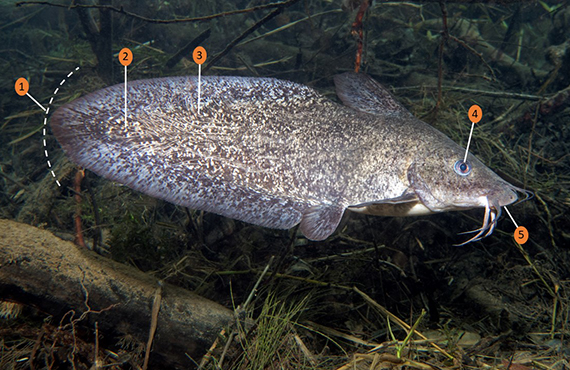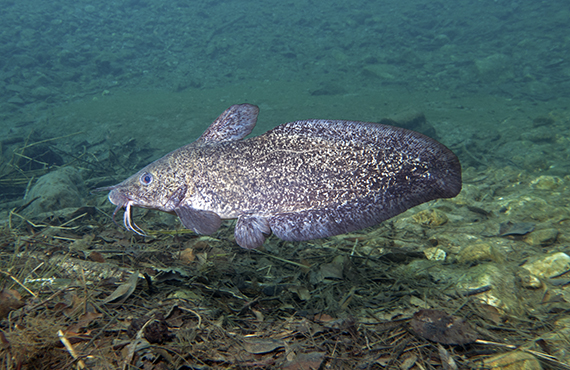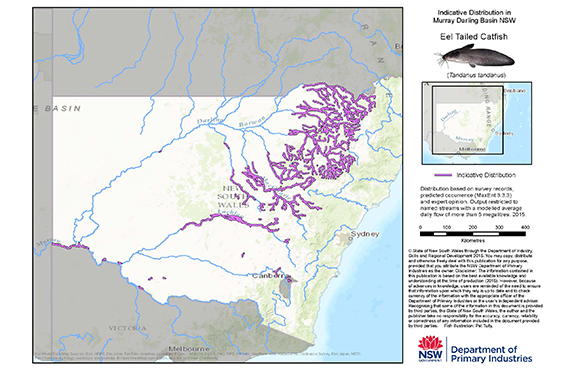
Eel-Tailed Catfish in the Murray-Darling Basin
Scientific name
Tandanus tandanus
Status in NSW
Endangered population. 
Characteristics
- Long, continuous fin comprising of the second dorsal, anal and caudal fins which are joined to form an eel-like tail.
- Rear portion of the body is compressed.
- Colour ranges from grey to brown, usually mottled with dark brown/black blotchings and a whitish underbelly. Larger fish have less mottling and can be more green in colour fading to white below. Skin is smooth with no scales.
- Small eyes.
- Down turned mouth surrounded by barbels.
Size
Can grow up to 900mm and 7kg, however fish over 2kg are exceptional.
Distribution
Eel Tailed Catfish are naturally distributed throughout the Murray-Darling Basin and in the Eastern drainages NSW north of Newcastle. Eel Tailed Catfish numbers in the Murray-Darling Basin have declined due to a range of impacts including invasive species, habitat degradation, cold water pollution and fishing pressures and are now virtually absent from the Murray, Murrumbidgee and Lachlan catchments.
- Freshwater threatened species distribution maps in NSW
- Report an Eel-Tailed Catfish sighting from the Murray-Darling Basin
Habitat
The Eel tailed catfish is a non-migratory, benthic (bottom dwelling) species. It is relatively sedentary and adults typically only move within a 5 km range. They are generally more active at night compared with during the day.
They can be found in a diverse range of freshwater environments including rivers, creeks, lakes, billabongs and lagoons. They prefer clear, sluggish or still waters, but can also be found in flowing streams with turbid waters. Substrates range from mud to gravel and rock.

Why is the Murray-Darling Basin population of Eel-Tailed Catfish threatened?
- Loss of suitable habitat (lakes, billabongs, lagoons) through river regulation.
- Competitive and predatory interactions with introduced species such as Common Carp (Cyprinus carpio) and Redfin Perch (Perca fluviatilis).
- Loss of habitat and spawning sites through siltation.
- Reduced success of spawning and recruitment due to alterations to flow patterns and flooding regimes.
- Reduced habitat and loss of temperature spawning cues due to cold-water discharge from the base of large dams and high-level weirs.
- Run-off of chemical pollution into waterways, including agricultural pesticides.
- Historical commercial and recreational overfishing.

More Information
- Fisheries Scientific Committee determination (November 2008) (PDF, 55.08 KB)
- Primefact: Murray-Darling population of Eel-Tailed Catfish
- Priorities Action Statement - Actions for Murray-Darling population of Eel Tailed Catfish
- Protecting Eel-Tailed Catfish in Western NSW - a guide for fishers and land managers
(PDF, 1248.17 KB) - Population genetic structure of freshwater catfish (Tandanus tandanus) in the Murray-Darling Basin and coastal catchments of New South Wales: Implications for future re-stocking programs (PDF, 1857.99 KB)
- Report on habitat requirements for freshwater catfish (PDF, 2082.07 KB)


